Impact of Night Ventilation on Indoor Thermal Environment of Residential Buildings under the Dual Carbon Target: A Case Study of Xi’an
Abstract
1. Introduction
2. Methods
2.1. Building Selection
2.2. Testing Instruments
2.3. Testing Requirements
2.4. Parameter Selection
2.5. Simulation
2.6. Evaluation Indicators
3. Results and Discussion
3.1. Meteorological Conditions in Xi’an
3.2. Model Verification
3.3. Impact of Daily Temperature Range on Indoor Air Quality
3.4. Impact of Daily Temperature Range on Average Indoor Radiation Temperature
3.5. Impact of Daily Temperature Range on Building Energy Consumption
4. Conclusions
- The average daily temperature from June to August in Xi’an ranges from 16.3 °C to 35.8 °C. When the variation in the daily temperature in a typical summer in Xi’an is larger than 6 °C, ventilation can be conducted at night. Night ventilation can be used for 76 days in this period, accounting for approximately 82.6% of the period.
- The indoor air and average radiation temperatures both decrease after adopting night ventilation and decrease with the increase in the daily temperature range. When the daily temperature range is 6 °C, 9 °C, 12 °C, and 15 °C, the average indoor temperature decreases by 0.26 °C, 0.55 °C, 0.80 °C, and 1.07 °C, respectively, compared with that for a daily temperature range of 3 °C. The highest temperatures decreased by 0.04 °C, 0.14 °C, 0.27 °C, and 0.33 °C, respectively; the lowest temperature decreased by 0.45 °C, 1.17 °C, 1.77 °C, and 2.33 °C, respectively.
- When the daily temperature range increases, the peak average indoor radiation temperature decreases and the overall building temperature decreases. When the daily temperature difference is 6 °C, 9 °C, 12 °C, and 15 °C, the average indoor radiation temperature decreases by 0.11 °C, 0.23 °C, 0.35 °C, and 0.47 °C with the use of night-time ventilation, respectively, compared with that when the daily temperature range is 3 °C.
- When the average daily outdoor temperature is high, the air conditioning system does not need to be operated for as long as the daily temperature range increases. When the daily temperature range is 15 °C, night ventilation reduces the time the air conditioning operates by 10.58 h. When the daily temperature range is 15 °C, the total energy consumption is reduced by 4.85 kWh, the electricity cost saved is 2.42 CNY/d, and the air conditioning operating cost saving index is 0.065 CNY/(m2·d). Compared with a daily temperature range of 3 °C, air conditioning operating costs are reduced by 63.7% with night ventilation. Our study provides a reference for building energy conservation and the creation of indoor thermal environments while meeting the dual carbon targets.
Author Contributions
Funding
Data Availability Statement
Conflicts of Interest
References
- Zhang, X.; Sun, H.; Li, K.P.; Nie, X.X.; Fan, Y.S.; Wang, H.; Ma, J.Y. Comparison of the Application of Three Methods for the Determination of Outdoor PM2.5 Design Concentrations for Fresh Air Filtration Systems in China. Int. J. Environ. Res. Public Health 2022, 19, 16537. [Google Scholar] [CrossRef] [PubMed]
- Lozinsky, C.H.; Touchie, M.F. Size matters (at least for interior air flow pathways): The indoor air quality and energy implications of compartmentalization in multi-unit residential buildings. Build. Environ. 2024, 253, 111275. [Google Scholar] [CrossRef]
- Ma, C.; Guerra-Santin, O.; Mohammadi, M. Exploring the influence of indoor environment and spatial layout on changed behaviours of people with dementia in a nursing home. Build. Environ. 2024, 256, 111452. [Google Scholar] [CrossRef]
- Kuppusamy, M.; Kim, S.W.; Lee, K.P.; Jo, Y.J.; Kim, W.J. Development of TiO2-CaCO3 Based Composites as an Affordable Building Material for the Photocatalytic Abatement of Hazardous NOx from the Environment. Nanomaterials 2024, 14, 136. [Google Scholar] [CrossRef] [PubMed]
- Niza, I.L.; de Souza, M.P.; da Luz, I.M.; Broday, E.E. Sick building syndrome and its impacts on health, well-being and productivity: A systematic literature review. Indoor Built Environ. 2024, 33, 218–236. [Google Scholar] [CrossRef]
- Kumar, P.; Singh, A.B.; Arora, T.; Singh, S.; Singh, R. Critical review on emerging health effects associated with the indoor air quality and its sustainable management. Sci. Total Environ. 2023, 872, 162163. [Google Scholar] [CrossRef]
- Chen, Q. Ventilation performance prediction for buildings: A method overview and recent applications. Build. Environ. 2009, 44, 848–858. [Google Scholar] [CrossRef]
- Solgi, E.; Hamedani, Z.; Fernando, R.; Skates, H.; Orji, N.E. A literature review of night ventilation strategies in buildings. Energy Build. 2018, 173, 337–352. [Google Scholar] [CrossRef]
- Truchet, S.; Jay, A.; Wurtz, E.; Anger, J.; Brun, A.; Bernaud, P. Impact of thermal inertia coupled to natural night ventilation. A case study for a high-performance building in continental climate. Int. J. Vent. 2024, 23, 25–38. [Google Scholar] [CrossRef]
- Blondeau, P.; Spérandio, M.; Allard, F. Night ventilation for building cooling in summer. Sol. Energy 1997, 61, 327–335. [Google Scholar] [CrossRef]
- Khakzand, M.; Deljouiee, B.; Chahardoli, S.; Siavashi, M. Radiative cooling ventilation improvement using an integrated system of windcatcher and solar chimney. J. Build. Eng. 2024, 83, 108409. [Google Scholar] [CrossRef]
- Lin, B.; Xie, C.H.; Chen, Y.; Xu, X. Natural Ventilation Potential of Residential Buildings in China Considering the Combined Effect of Indoor and Outdoor Air Pollution. Buildings 2024, 14, 363. [Google Scholar] [CrossRef]
- Al-Rikabi, I.J.; Karam, J.; Alsaad, H.; Ghali, K.; Ghaddar, N.; Voelker, C. The impact of mechanical and natural ventilation modes on the spread of indoor airborne contaminants: A review. J. Build. Eng. 2024, 85, 108715. [Google Scholar] [CrossRef]
- Zhu, D.; Yu, B.; Wang, D.; Zhang, Y. Fusion of finite element and machine learning methods to predict rock shear strength parameters. J. Geophys. Eng. 2024, 21, 1183–1193. [Google Scholar] [CrossRef]
- Belpoliti, V.; Mushtaha, E.S.; Saleem, A.A.; Elmualim, A.A. Assessment of Natural Ventilation Techniques by Means of Measurements and Retrospective CFD Simulation on a Test Building. J. Archit. Eng. 2024, 30, 04024011. [Google Scholar] [CrossRef]
- Santamouris, M.; Sfakianaki, A.; Pavlou, K. On the efficiency of night ventilation techniques applied to residential buildings. Energy Build. 2010, 42, 1309–1313. [Google Scholar] [CrossRef]
- Kubota, T.; Chyee, D.T.H.; Ahmad, S. The effects of night ventilation technique on indoor thermal environment for residential buildings in hot-humid climate of Malaysia. Energy Build. 2009, 41, 829–839. [Google Scholar] [CrossRef]
- Soudian, S.; Berardi, U. Assessing the effect of night ventilation on PCM performance in high-rise residential buildings. J. Build. Phys. 2019, 43, 229–249. [Google Scholar] [CrossRef]
- Mahach, H.; Lafqir, F.E.; Benhamou, B.; Bennouna, A.; Schmidt, C.; Groß, B.; Altgeld, H. Impact of an Earth-Air Heat Exchanger combined with nighttime ventilation on indoor thermal comfort of a residential building in hot semi-arid climate. J. Sol. Energy T ASME 2023, 145, 011002. [Google Scholar] [CrossRef]
- Lestinen, S.; Kilpeläinen, S.; Kosonen, R.; Valkonen, M.; Jokisalo, J.; Pasanen, P. Effects of Night Ventilation on Indoor Air Quality in Educational Buildings—A Field Study. Appl. Sci. 2021, 11, 4056. [Google Scholar] [CrossRef]
- Knudsen, M.; Rissetto, R.; Carbonare, N.; Wagner, A.; Schweiker, M. Comfort and economic viability of personal ceiling fans assisted by night ventilation in a renovated office building. Buildings 2023, 13, 589. [Google Scholar] [CrossRef]
- Sun, W.J.; Chen, L.X.; Suolang, B.M.; Liu, K. An Investigation of the Energy-Saving Optimization Design of the Enclosure Structure in High-Altitude Office Buildings. Buildings 2024, 14, 645. [Google Scholar] [CrossRef]
- Alavy, M.; Shirazi, P.; Rosen, M.A. Effectiveness of phase change materials and their properties on the performance of geothermal and Foundation-Based energy Systems: A review. Appl. Therm. Eng. 2024, 246, 122903. [Google Scholar] [CrossRef]
- Arumugam, P.; Ramalingam, V. Thermal comfort enhancement of office buildings located under warm and humid climate through phase change material and insulation coupled with natural ventilation. Sustain. Energy Technol. 2024, 63, 103657. [Google Scholar] [CrossRef]
- Lee, H. Strategic types, implementation, and capabilities: Sustainability policies of local governments. Public Admin. 2024, 102, 264–284. [Google Scholar] [CrossRef]
- Wang, Z.S.; Wu, Y.; Jia, Z.Y.; Gao, Q.; Gu, Z.L. Research on health and thermal comfort of unit-type student apartments in the western China science and technology innovation harbor. Front. Public Health 2022, 10, 850107. [Google Scholar] [CrossRef] [PubMed]
- Jeon, J.; Chen, Y.; Kim, H. Influences of meteorology on emission sources and physicochemical properties of particulate matter in Seoul, Korea during the heating period. Atmos. Environ. 2023, 303, 119733. [Google Scholar] [CrossRef]
- Li, K.J.; Zhou, Y.; Huang, X.H.; Xiao, H.J.; Shan, Y.L. Low-carbon development pathways for resource-based cities in China under the carbon peaking and carbon neutrality goals. Environ. Sci. Pollut. R 2024, 31, 10213–10233. [Google Scholar] [CrossRef] [PubMed]
- GB/T18883-2022; Standards for indoor air quality. State Administration for Market Regulation, Standardization administration of the People’s Republic of China: Beijing, China, 2022.
- Stamatopoulou, V.; Akoumianaki, E.; Vaporidi, K.; Stamatopoulos, E.; Kondili, E.; Georgopoulos, D. Driving pressure of respiratory system and lung stress in mechanically ventilated patients with active breathing. Crit. Care 2024, 28, 19. [Google Scholar] [CrossRef]
- El Fouih, Y.; Stabat, P.; Rivière, P.; Hoang, P.; Archambault, V. Adequacy of air-to-air heat recovery ventilation system applied in low energy buildings. Energy Build. 2012, 54, 29–39. [Google Scholar] [CrossRef]
- EN 13779; Ventilation for Non-Residential Buildings-Performance Requirements for Ventilation and Room-Conditioning Systems. European Committee for Standardization: Brussels, Belgium, 2010.
- Zang, Z.Y. Study on Indoor Thermal Environment and Energy Consumption by Night Ventilation of Residential Buildings in Xi’an. Master’s Thesis, Xi’an University of Architecture and Technology, Xi’an, China, 2019. (In Chinese). [Google Scholar]
- Ma, H.L.; Wang, J.F.; Ji, M. DEST simulation using the window on the building energy consumption. Adv. Mater. Res. 2011, 282, 257–260. [Google Scholar]
- Huo, X.J.; Yang, L.; Li, D.H.W. Determining Weibull distribution patterns for wind conditions in building energy-efficient design across the different thermal design zones in China. Energy 2024, 304, 132013. [Google Scholar] [CrossRef]
- Li, N.; Yang, L.; Zhu, X.B. Experimental Study on nighttime ventilation cooling in office buildings in Xi’an area. Heat. Vent. Air Cond. 2015, 45, 106–110. (In Chinese) [Google Scholar]
- Johra, H.; Heiselberg, P. Influence of internal thermal mass on the indoor thermal dynamics and integration of phase change materials in furniture for building energy storage: A review. Renew. Sustain. Energy Rev. 2017, 69, 19–32. [Google Scholar] [CrossRef]
- GB 50736-2012; Design Code for Heating Ventilation and Air Conditioning of Civil Buildings. Ministry of Housing and Urban-Rural Development of the People’s Republic of China: Beijing, China, 2012.
- Keig, P.; Hyde, T.; McGill, G. A comparison of the estimated natural ventilation rates of four solid wall houses with the measured ventilation rates and the implications for low-energy retrofits. Indoor Built Environ. 2016, 25, 169–179. [Google Scholar] [CrossRef]
- Elnabawi, M.H.; Saber, E. A numerical study of cool and green roof strategies on indoor energy saving and outdoor cooling impact at pedestrian level in a hot arid climate. J. Build. Perform. Simul. 2023, 16, 72–89. [Google Scholar] [CrossRef]
- Di Perna, C.; Stazi, F.; Casalena, A.U.; D’Orazio, M. Influence of the internal inertia of the building envelope on summertime comfort in buildings with high internal heat loads. Energy Build. 2011, 43, 200–206. [Google Scholar] [CrossRef]
- Li, X.X.; Huang, K.L.; Feng, G.H.; Li, W.Y.; Wei, J.X. Night ventilation scheme optimization for an Ultra-low energy consumption building in Shenyang, China. Energy Rep. 2022, 8, 8426–8436. [Google Scholar] [CrossRef]
- Chen, Z.; Li, J.; Tang, G.; Zhang, J.; Zhang, D.; Gao, P. High-efficiency heating and cooling technology with embedded pipes in buildings and underground structures: A review. Renew. Sustain. Energy Rev. 2024, 192, 114209. [Google Scholar] [CrossRef]
- Lissen, J.M.S.; Fernández, J.A.S.; Flor, F.J.S.D.L.; Domínguez, S.Á.; Pardo, Á.R. Flow pattern effects on night cooling ventilation. Int. J. Vent. 2007, 6, 21–30. [Google Scholar] [CrossRef]



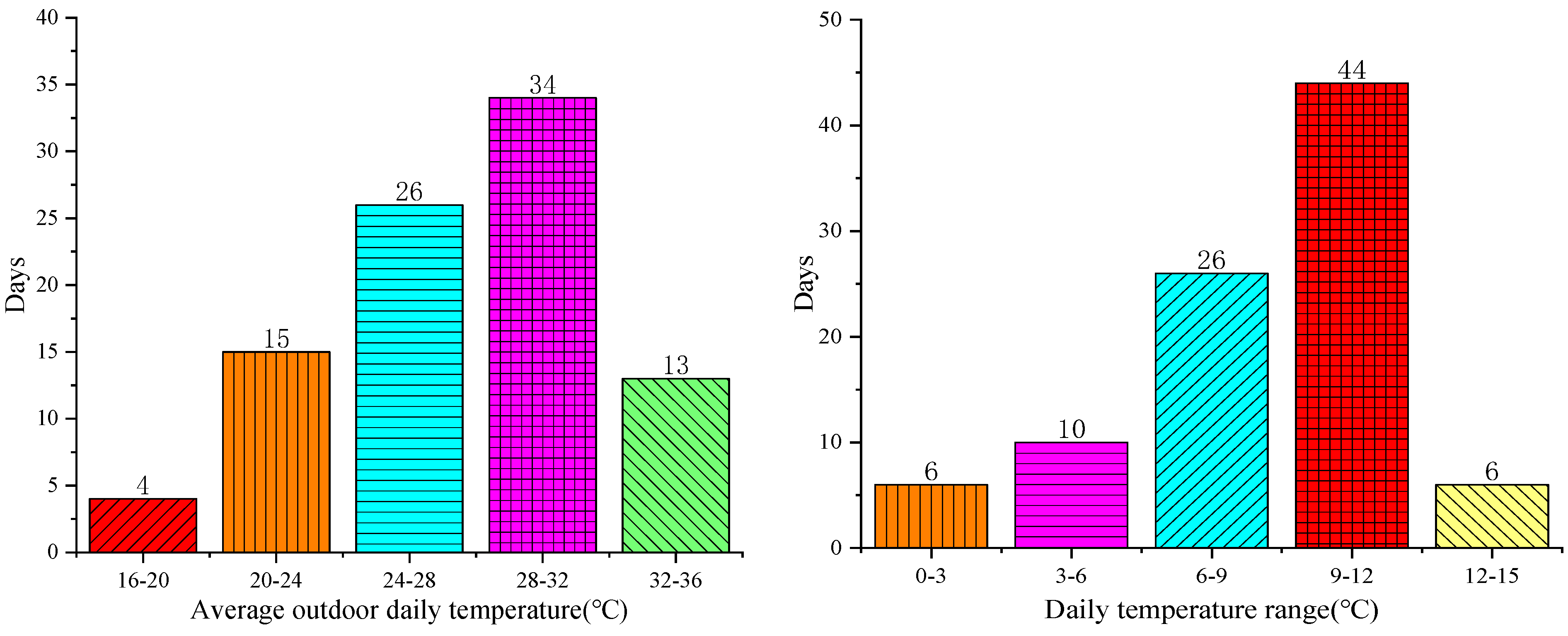
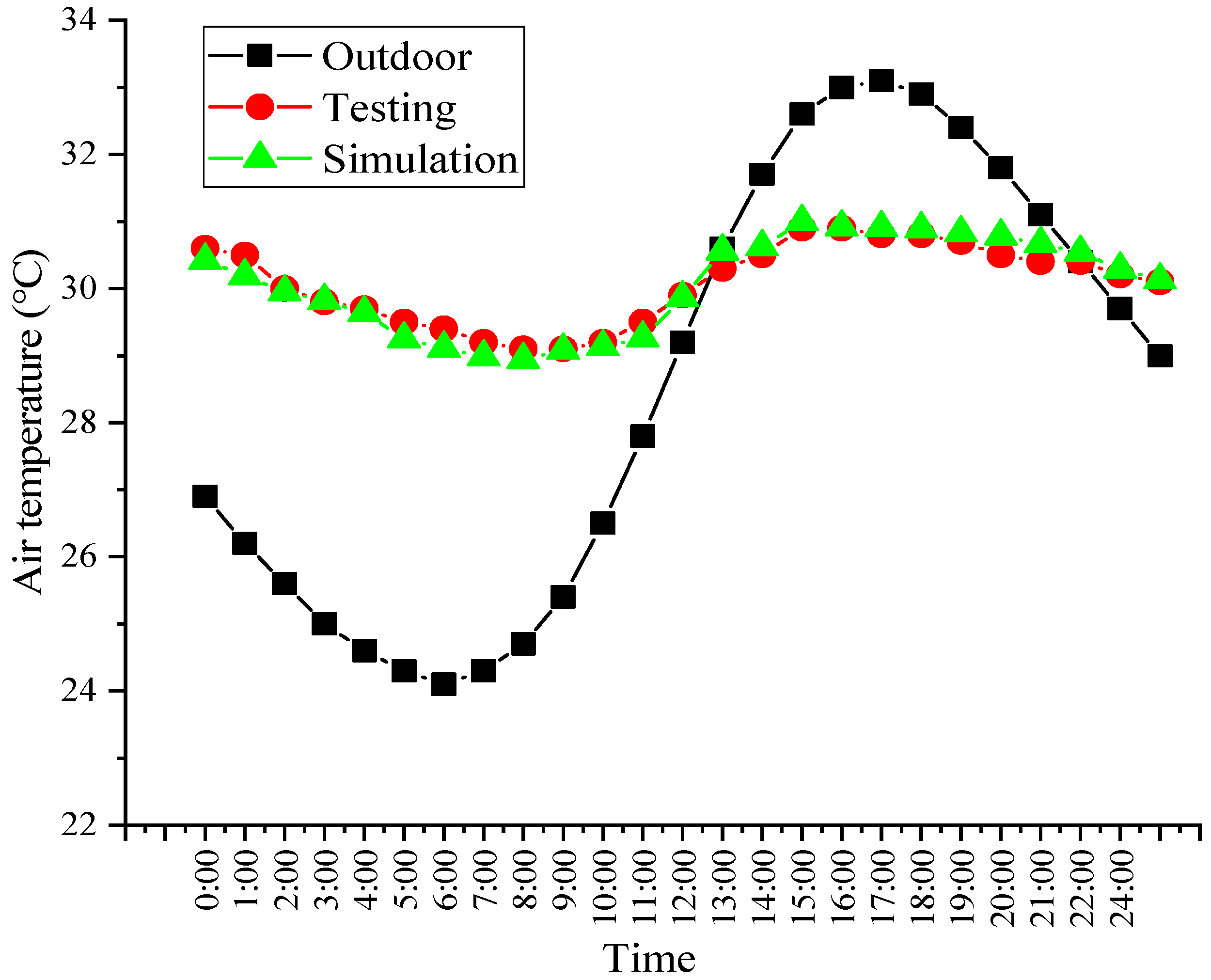

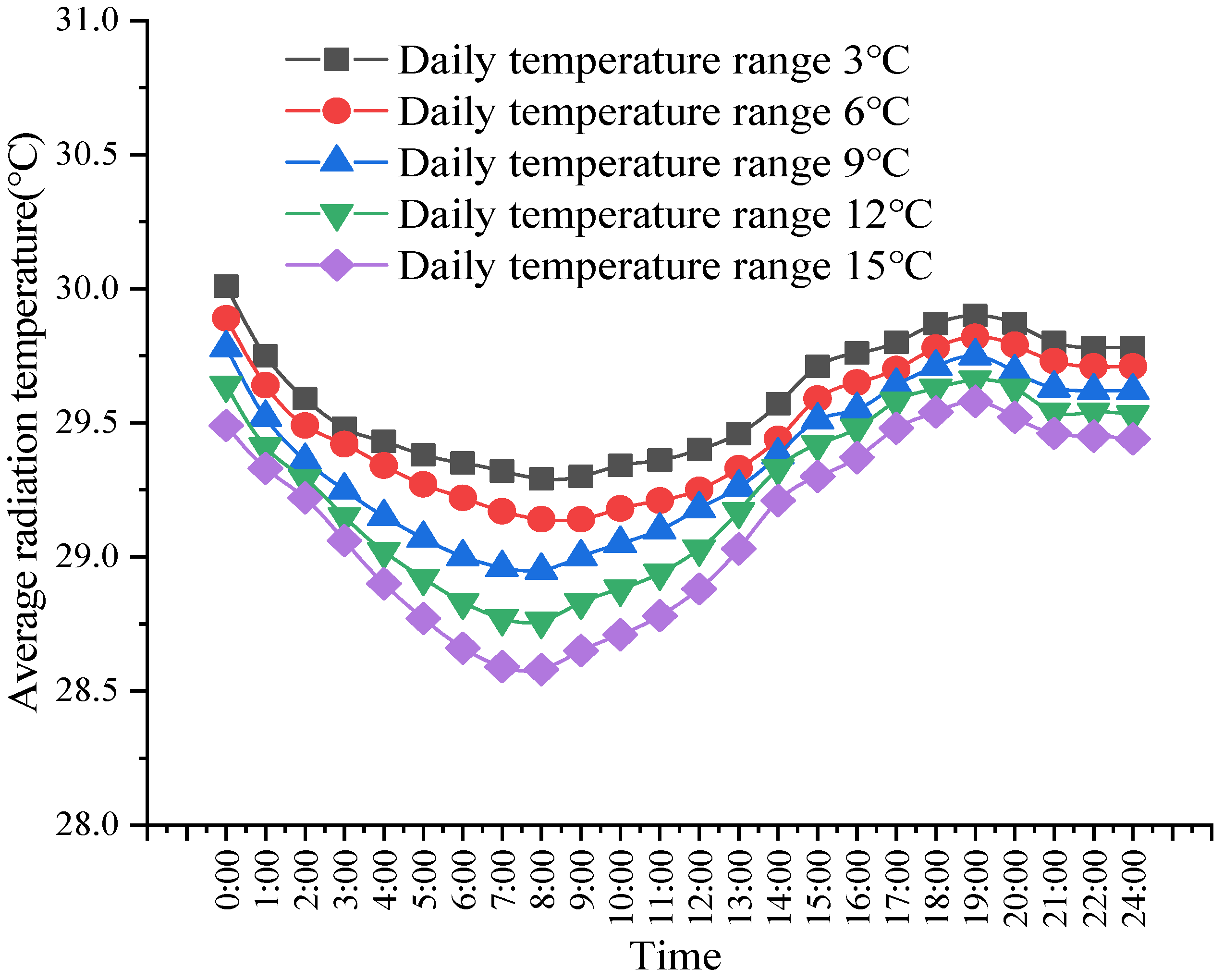
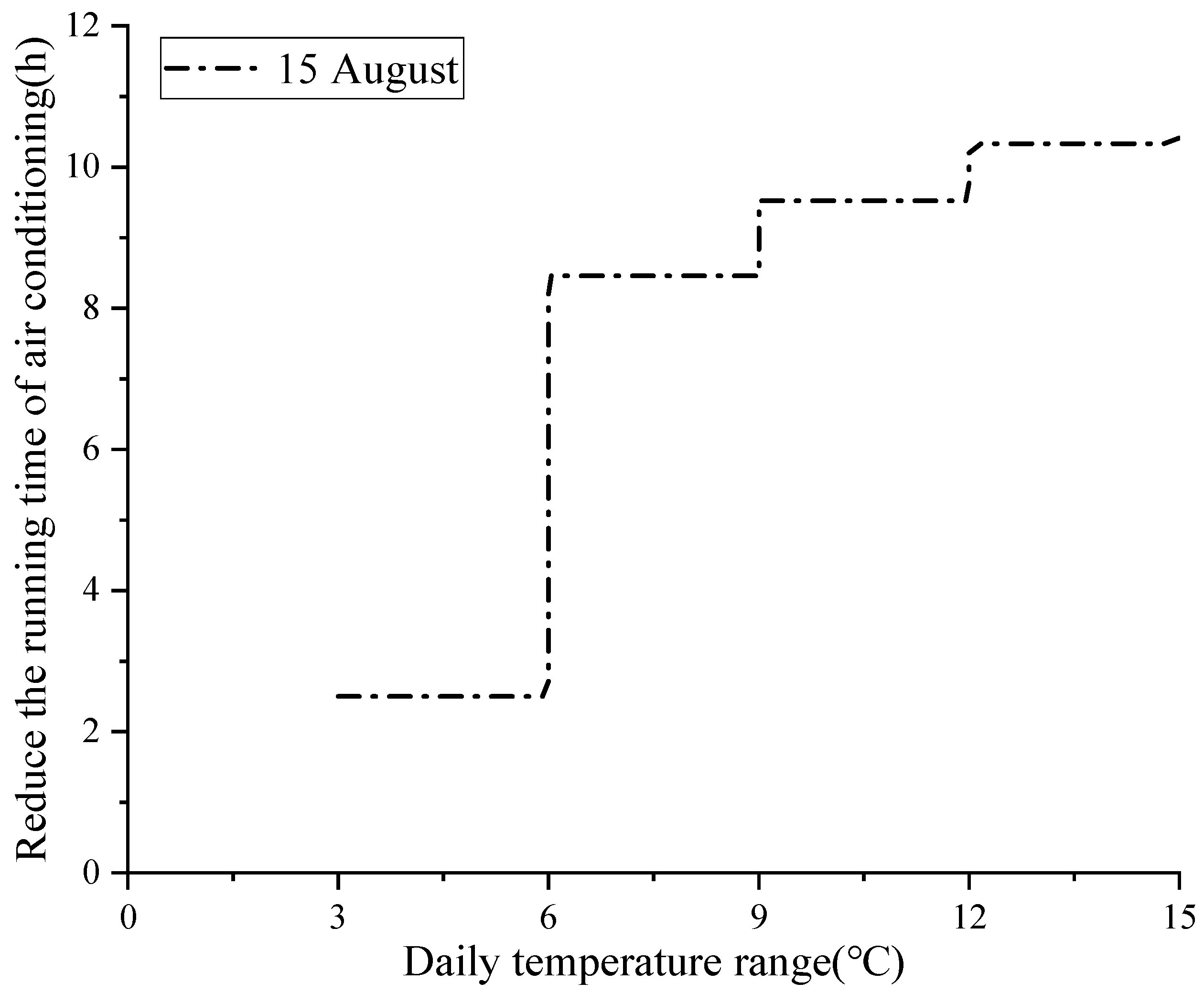
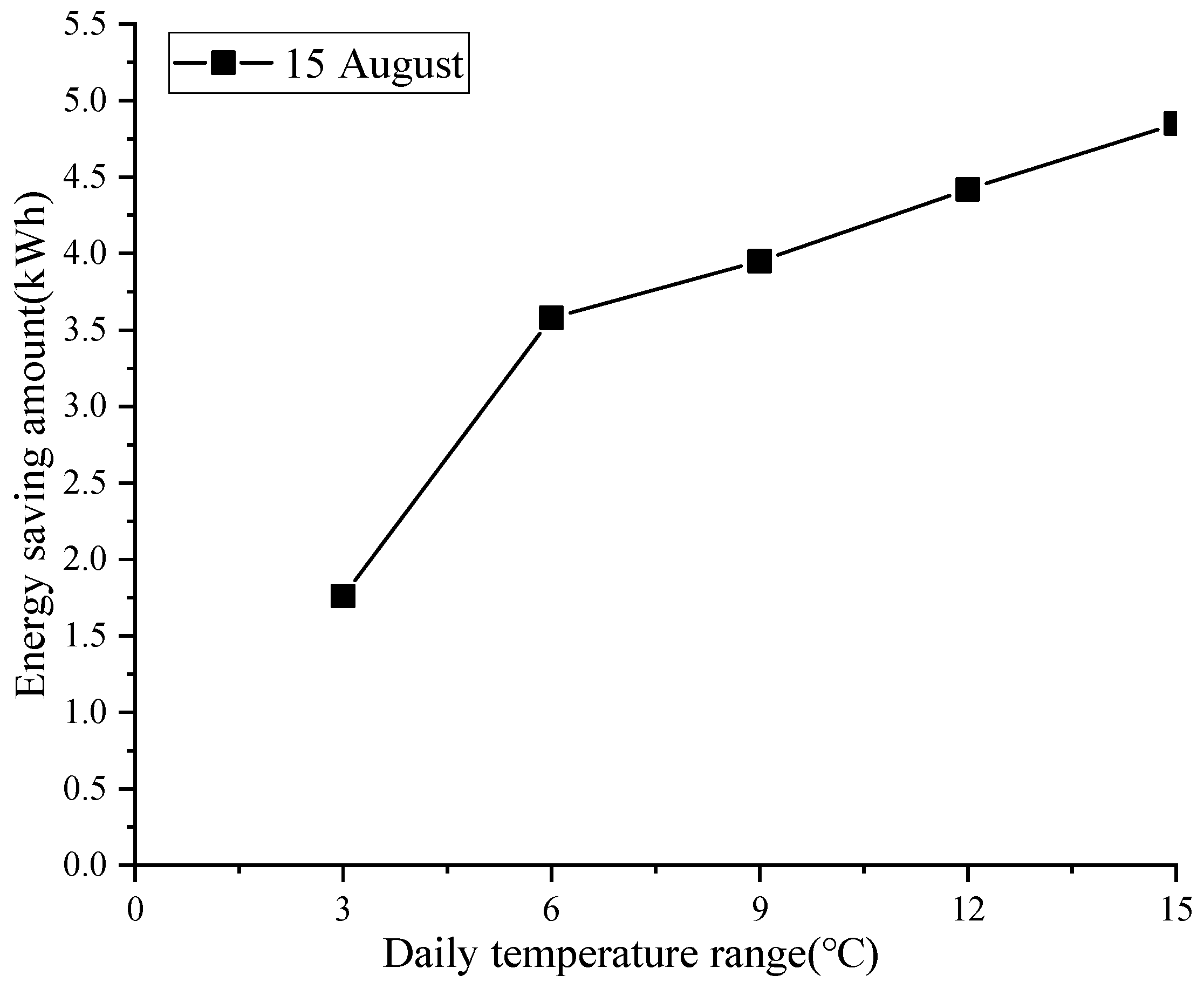
| Instrument | Manufacturer | Test Content | Range | Resolution | Accuracy |
|---|---|---|---|---|---|
| IAQ-Calc7525 indoor air quality detector | TSI Instrument Beijing Co., Ltd., Beijing, China | Temperature | 0~60 °C | 0.1 °C | ±0.6 °C |
| Relative humidity | 5~95% RH | 0.1% RH | ±3.0% RH | ||
| Vantage Pro2 Plus small weather station | Shaanxi Furunke Electronic Technology Co., Ltd., Xi’an, China | Temperature | −40~65 °C | 0.1 °C | ±0.5 °C |
| Relative humidity | 0~100% RH | 1% RH | ±3.0% RH | ||
| Wind speed | 1~67 m/s | 0.1 m/s | ±5% | ||
| Atmospheric pressure | 880~1080 hPa | 0.1 hPa | ±1 hPa |
| Enclosure Structure | Exterior Wall | Internal Wall | Floor | Roofing | Outer Window | Door |
|---|---|---|---|---|---|---|
| Heat transfer coefficient (W·m−2K−1) | 0.69 | 1.52 | 3.1 | 0.43 | 2.1 | 1.5 |
Disclaimer/Publisher’s Note: The statements, opinions and data contained in all publications are solely those of the individual author(s) and contributor(s) and not of MDPI and/or the editor(s). MDPI and/or the editor(s) disclaim responsibility for any injury to people or property resulting from any ideas, methods, instructions or products referred to in the content. |
© 2024 by the authors. Licensee MDPI, Basel, Switzerland. This article is an open access article distributed under the terms and conditions of the Creative Commons Attribution (CC BY) license (https://creativecommons.org/licenses/by/4.0/).
Share and Cite
Xiang, H.; Li, J. Impact of Night Ventilation on Indoor Thermal Environment of Residential Buildings under the Dual Carbon Target: A Case Study of Xi’an. Buildings 2024, 14, 2459. https://doi.org/10.3390/buildings14082459
Xiang H, Li J. Impact of Night Ventilation on Indoor Thermal Environment of Residential Buildings under the Dual Carbon Target: A Case Study of Xi’an. Buildings. 2024; 14(8):2459. https://doi.org/10.3390/buildings14082459
Chicago/Turabian StyleXiang, Hongyan, and Jing Li. 2024. "Impact of Night Ventilation on Indoor Thermal Environment of Residential Buildings under the Dual Carbon Target: A Case Study of Xi’an" Buildings 14, no. 8: 2459. https://doi.org/10.3390/buildings14082459
APA StyleXiang, H., & Li, J. (2024). Impact of Night Ventilation on Indoor Thermal Environment of Residential Buildings under the Dual Carbon Target: A Case Study of Xi’an. Buildings, 14(8), 2459. https://doi.org/10.3390/buildings14082459





